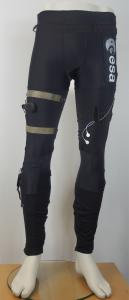Non-invasive muscle activity and metabolism monitoring
Programme
GSTP
Programme Reference
G613-001MM
Prime Contractor
OHMATEX A/S
Start Date
End Date
Status
Closed
Country
Denmark

Objectives
The main objectives of the proposed activity are:
- The improvement of the current system design including upgrade/addition of system functionalities, implementation of corrective items identified in the earlier project phase.
- The development of the upgraded system.
- The definition of a validation approach aimed at quantifying the benefits of this technology.
- The performance of validation test campaign as per test plans and procedures.
Description
The musculo-skelettal system is victim of the deleterious effects on the human body caused by a prolonged exposure to a weightless environment.
The proposed activity is a follow-up of an ESA activity aiming at providing new complementary knowledge about the efficiency of countermeasure exercise programmes in preventing muscle atrophy, with potential use for design (andmonitoring) of training programmes to stimulate specific muscle groups and for rehabilitation.
Current data is typically collected using opto-electronic systems (camera-basedsystems) and EMG sensors in a gait laboratory on Earth before and after space flight missions. Opportunities for similar measurements (over longer time periods) on ISS are limited. This is what prompted NASA to devise the Lower Extremity Monitoring Suit (LEMS) that was partially based on COTS technologies and custom built for each astronaut in order to record data on biomechanical activity (leg angles, limb extension and muscular activity). Experience from the LEMS suits shows that skin preparation was necessary and that some EMG sensor displacement occurred during exercise activities. There were also some design criticisms with astronauts reporting interference from treadmill bungees when using the device. Most notably, real-time data analysis was not possible due to the inability of the data collection system to transmit these data wirelessly to other systems.
The proposed project will not develop garments that record limb positions, but will instead register the activity of individual muscles and muscle groups non-invasively and unobtrusively by mounting sensors that do not require skin contact on a wearable platform with fully integrated circuitry for power supply, data collection and real-time wireless data transfer. The EMG sensors developed under the current contract provide reliable data without the use of gels to establish adequate skin contact, while the small sized NIRS sensor returns a clear signal of light intensity that can be used to calculate changes in concentration of oxyhemoglobin to provide an indication of developments in blood oxygenation and muscle metabolism. In the current project these sensors are closely coupled with the knitted platform which comprises an integrated textile bus for both power supply and data sampling with wireless communication to a remote PC interface.
Reusing and maturing the technologies developed under the existing contract, the proposed concept is for a modularly based system that can be used to monitor EMG signals and blood oxygenation of selected muscle groups for all of the extremities. A stretch fabric device platform with integrated power and data bus will be demonstrated and confectioned as the basis for a long-sleeved T-shirt andclose fitting cycling trousers/tights for monitoring of muscle activity and plethysmographic measurements of limb volume.
This will enable device trials in ground based situations on relevant test subjects. In a second step the system could be tested on astronauts in pre/post flight conditions.
In particular, the following tasks will be performed:
- Consolidation of user needs and requirements: within this task, the contractor is expect to review and consolidation scenarios, user and operational requirements, which shall be translated into a systemrequirements.
- Safety analysis: within this task, which will be transversal and carried out from the start to the conclusion of the activity, the contractor shall in particular perform a safetyanalysis, provide inpout to the design phase and prepare all documentation(e.g. ethical files) for the performance of validation involving human beings.
- Consolidated design: within this task, the contractor is expected to identify critical aspects, develop the design as per requirements, identify test methods and prepare a draft testplan (technical test plan, scientific evaluation plan), specify the list of procurements to be done.
- Manufacturing, integration and technical testing: the contractor shall manufacture and assemble the system, perform the technical and funtional test, prepare the user manual and perform the safetytests.
- Scientific validation: within this task, the contractor shall perform scientific validation as per scientific test plan and evaluate scientific test results.
Application Domain
Exploration
Technology Domain
22 - Environmental Control & Life Support (ECLS) and In Situ Resource Utilisation (ISRU)
Competence Domain
6-Life & Physical Science Payloads, Life Support, Robotics & Automation
Initial TRL
TRL 3
Target TRL
TRL 6
Achieved TRL
TRL 6
Public Document
Final Presentation
